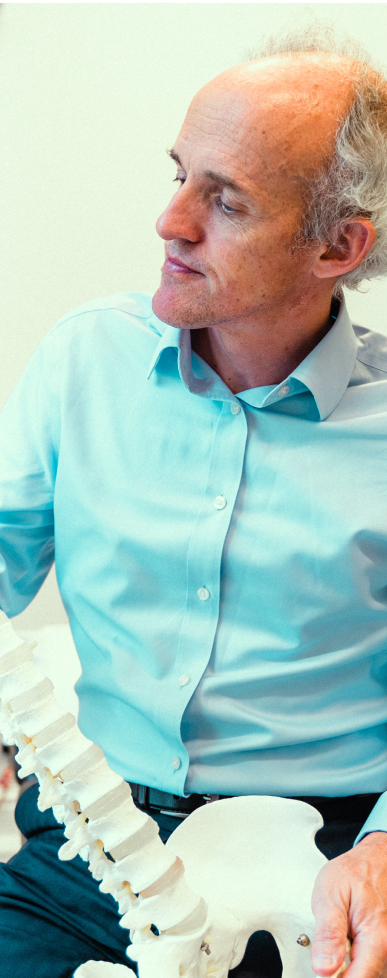Understanding
Spinal Stenosis
- A narrowing of the space within the spine
- Typically caused by age related changes
- Treatable with physical therapy, spine injections, through to spine surgery depending on the extent of the issue.

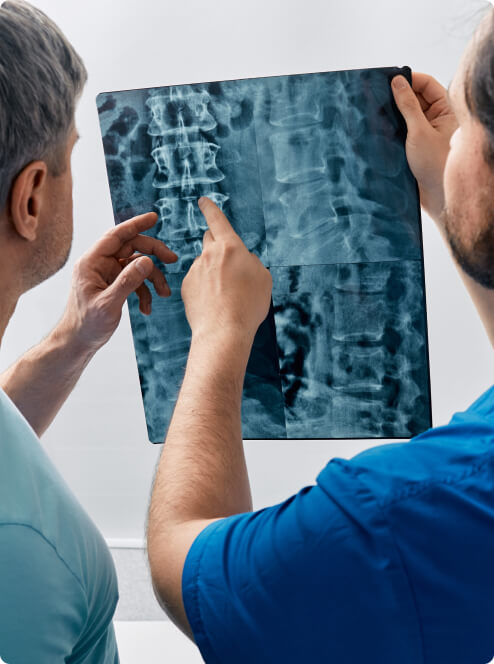
What is Spinal Stenosis?
Spinal stenosis simply means ‘narrowing’ of the space within your spine. In the neck this is called cervical spinal stenosis in the lower back lumbar spinal stenosis. Stenosis becomes more common as we get older. Stenosis can put pressure on the nerves that travel through the spine, often resulting in pain, numbness, pins and needles, or muscle weakness affecting the arms or legs. Typically affecting the neck and lower back, the condition can severely impact walking, mobility and overall quality of life.
What is the main cause of spinal stenosis?
Spinal stenosis is usually caused by age related degenerative changes in the spine which is associated with degeneration of the facet joints with overgrowth of the joints, bulging of discs, disc herniation (disc protrusion) in-folding of the ligamentum flavum, facet cysts, build-up of epidural fat in the spinal canal, and other causes.
Is spinal stenosis hereditary?
Yes, to some degree. If you are born with a narrow spinal canal then you are more likely to develop spinal stenosis with age because there is less room to start with. However spinal stenosis is common and can affect anyone. Also the more degeneration or arthritis you develop in the spine the greater the risk of developing stenosis.
Learn more about
your symptoms
Use our DiagnoseMe Analyser to give you a steer on your condition and the next steps
What are the symptoms of spinal stenosis?
Compression of exiting nerves in the neck can lead to pain, pins and needles, numbness and weakness spreading from the neck, through the shoulder and down the arm to the fingers. Compression of the spinal cord in the neck or thoracic spine can lead to a loss of co-ordination or dexterity with difficulty writing or doing up buttons. Electric type shocks may be experienced across the body or down the arms. Walking imbalance is common with spinal cord compression leading to a tendency to trip or fall. Bladder and bowel dysfunction can follow if severe.
Lumbar spine stenosis can lead to pain, pins and needles or numbness radiating from the buttock down the leg to the foot which is called sciatica. Also increasing low back pain with heaviness or weakness in the legs brought on by standing and walking, and relieved by sitting is a typical presentation.
In summary, the symptoms of spinal stenosis can vary greatly depending on the severity and location of the condition. However, common symptoms can include
- Back Pain: One of the most common symptoms, often worsened when standing or walking.
- Numbness or Tingling: These sensations may occur in your hands, arms, feet, or legs.
- Weakness: You may experience a loss of strength in your hands, arms, feet, or legs.
- Balance Problems: Difficulty with balance and coordination can occur, increasing the risk of falls.
- Bowel or Bladder Dysfunction: In severe cases, people may lose control of bowel or bladder functions.
- Cauda Equina Syndrome: Although rare, this is a serious condition where the nerves at the end of the spinal cord are squeezed. Seek medical help immediately if you have these symptoms.
If you are experiencing any of the above symptoms, it is essential to consult with a spine specialist as soon as possible. Remember, early diagnosis and treatment can considerably improve the quality of life for individuals with spinal stenosis.

Frequently Asked Questions About Spinal Stenosis
What is considered severe spinal stenosis?
This is usually a description of the MRI appearances which are graded mild, moderate or severe. However this does not necessarily correlate with a patients symptoms and sometimes a patient with severe spinal stenosis on MRI scan may have few symptoms or conversely a patient with relatively mild stenosis on an MRI scan may have severe sciatic pain going down a leg. As specialists we treat patients not scans so interpreting an MRI in relation to symptoms is very important part of assessment.
Conservative treatments rarely work for severe symptomatic spinal stenosis, however surgical decompression usually works very well.
How serious is severe spinal stenosis?
Spinal stenosis is not usually ‘serious’ unless the spinal cord is compressed which can lead to permanent damage to the spinal cord and permanent neurological symptoms.
Most spinal stenosis involves the individual nerve roots in the lumbar spine leading to unpleasant symptoms affecting the legs. This is an impairment of quality of life and function but is eminently treatable by an experienced specialist.
Is spinal stenosis a permanent disability?
No. Most spinal stenosis can be effectively treated by an experienced specialist. However untreated compression of the spinal cord in the cervical or thoracic spine can lead to permanent damage.
Are spinal stenosis and sciatica the same thing?
No. Spinal stenosis simply describes the appearance of narrowing of the spinal canal as seen on an MRI scan. Spinal stenosis may cause no symptoms whatsoever and may be an incidental finding on an MRI. Variable degrees of spinal stenosis are commonly described in the MRI report in the ageing spine.
Sciatica is a collection of ‘symptoms’ experienced by the individual and classically might include pain, pins and needles, or numbness radiating down the leg from the lower back or buttock, extending beyond the knee to the ankle or foot. Sciatica is usually a symptom of spinal stenosis.
How do we diagnose Spinal Stenosis?
It’s easy to get access to treatment for stenosis once we establish that you have the condition.

1 Speak to us
We will discuss the options that work for you in a free 15 minute consultation
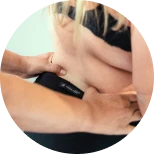
2 Book an appointment
visit our state of the art Harley Street clinic or we offer video consultations
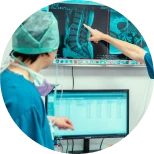
3 On the Day Diagnosis
Get assessed, scanned and diagnosed in one day
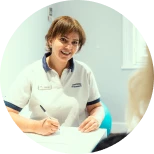
4 Same Day Treatment
Receive your treatment from the same specialist

5 Follow Up Consultation (FREE and included)
To make sure you are better and back to doing what you love

How is spinal stenosis diagnosed?
Spinal stenosis is suspected by the history of leg or arm symptoms. The gold standard for diagnosis is an MRI scan. CT scan is much less good at visualising stenosis and reserved for patients who are unable to have an MRI scan (eg. Pacemaker…). An Xray of the spine is not sufficient to diagnose stenosis.
What is the best treatment for spinal
stenosis?
Several treatments are available for spinal stenosis, depending on the severity of your condition. Non-surgical treatments include physical therapy, anti-inflammatory medications, and epidural or spine injections.
Spine injections are very simple and safe and are often a good first option to try and may avoid the need for surgery. If injections prove ineffective or if stenosis is severe, surgical treatment usually decompression (terms like laminectomy or laminotomy simply describe decompression) is usually very effective. If there is spinal instability or deformity associated with stenosis it might be necessary to stabilise the spine either traditionally with a spinal fusion or potentially using dynamic stabilisation. It is important to discuss these options with your specialist to determine the most appropriate treatment for you.
Most spinal surgery is performed to treat spinal stenosis. The reason for this is that decompression surgery for spinal stenosis is usually very effective with an 80-90% chance of lasting relief.
A comprehensive range of treatments for spinal stenosis
We offer a range of treatments to resolve spinal stenosis.
Spine Injections
Injections are an excellent first option and may avoid the need for more involved treatments or surgery. Performed painlessly with sedation if you wish.
Lumbar Microdiscectomy
One of our most routinely performed operations ideal for key hole surgery. Sciatica better and home the same day.
Lumbar Fusion
One of our most routinely performed operations ideal for key hole surgery. Sciatica better and home the same day.
Laser Disc Surgery
One of our most routinely performed operations ideal for key hole surgery. Sciatica better and home the same day.
Can spinal stenosis be cured?
Yes. Non-operative treatments such as physical therapy, analgesia, or spine injections can relieve the symptoms of spinal stenosis particularly when less severe.
However spinal decompression physically opens up the narrowed spinal canal and can cure the condition completely. Surgery for stenosis is usually very effective.
Can you fix spinal stenosis without surgery?
The symptoms of mild or moderate spinal stenosis can often be effectively relieved with non-operative treatments. However physical narrowing in the spinal canal ‘stenosis’ will persist unless physically decompressed through surgery. This implies that without formally decompressing the spinal canal with surgery there is potential for sciatic type symptoms to recur. Decompressive surgery relieves the physical narrowing once and for all reducing the chance of recurrent symptoms.
Physical therapy for spinal stenosis?
Physical therapy is often a good first option for trying to relieve the symptoms of spinal stenosis. This is usually based around gentle stretching exercises. Manipulation of the spine should be avoided as this can aggravate nerve root symptoms.
There is very little downside to trying physical therapy however it is unlikely to relieve symptoms if stenosis is severe.
Medications for spinal stenosis?
Over the counter medications such as paracetamol or anti-inflammatories such as ibuprofen are sensible first line agents. Codeine phosphate or co-codamol is also available without prescription. Prescribed second line agents include gabapentin/pre-gabalin or amitriptyline. These drugs are good for nerve related pain but may be associated with side-effects. Opiate based analgesia is not particularly effective for nerve pain and is associated with problems of tolerance and dependancy.
Medications are generally ineffective for symptoms arising from severe spinal stenosis. Similarly pain management approaches are rarely effective or the best option for managing this common and often treatable condition.
Injections for spinal stenosis?
Spine injections are simple and very safe and can work well at settling sciatic type symptoms arising from spinal stenosis. Injections use a strong anti-inflammatory (steroid) which helps to reduce inflammation, redness and swelling associated with the compressed nerves. Injections can work very well in some individuals but may not work or last in others.
Spine injections should only be performed by a spine specialist and are usually carried out in theatre and require imaging guidance. They can be performed using either local anaesthetic or under light sedation.
Injections are often a good first option alongside physical therapy and before the last resort which is surgery.
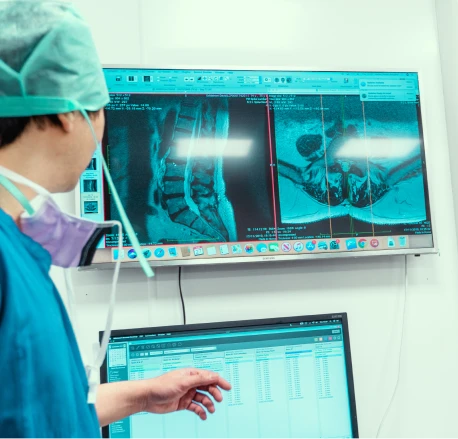
I could hardly walk at all and sought Mr Aylott’s help. I had an operation for spinal decompression and to date it was a success. I was extremely pleased with the service and procedure performed.
A spine surgeon’s view on Spinal Stenosis
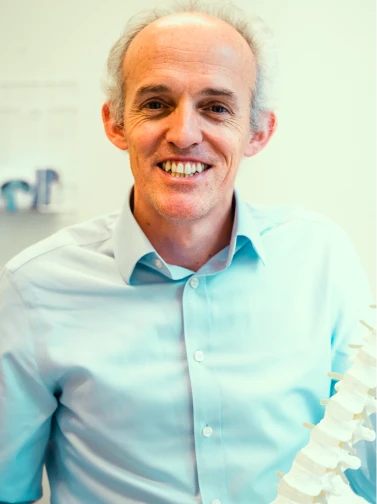
As a spine surgeon I often say to patients ‘we like spinal stenosis’ because we can target the problem very specifically with either injections or minimally invasive decompression and therefore treatments work well. Spinal Stenosis is one of the most curable problems which we see with an excellent chance (90%) we can resolve this problem successfully.
Caspar Aylott
B.Eng(Hons), MB ChB, MRCS, FRCS (Tr Orth), DM

Surgery for Spinal Stenosis
Surgery for spinal stenosis usually involves a posterior decompression. This involves nibbling away the excess bone, disc, or ligament which is causing the narrowing and compression of the nerves. This can be performed by a minimally invasive ‘keyhole’ approach or more traditional open surgery.
Sometimes it is helpful or necessary to combine the decompression with stabilisation of the spine if there is a spinal deformity or excessive movement/instability in the spine. An example of this might be a vertebral slippage called a spondylolisthesis.
Stabilisation may involve a traditional fusion with rods and screws or the smaller option of dynamic stabilisation may work well. Some options may not be offered to you either if unavailable through the Hospital or NHS or not within the experience of the specialist. An experienced specialist should advise when stabilisation is also required.
In our experience the combination of keyhole surgery with special anesthetic techniques allows all our patients to be up and about and walking within a few hours of surgery and able to go home on the same day. This is unique and a big advantage for our patients, contributing to a more rapid recovery.
How much does spinal stenosis surgery cost?
Cost depends on whether surgery requires single level or multilevel decompression and also whether some form of spinal stabilisation is also required alongside the decompression. The use of a spinal implant for stabilisation will increase cost. This should be discussed by the specialist. In a specialist center costs usually start from approximately £10,000.
What is the prognosis for recovery?
Spinal stenosis is the most common treatable spinal condition and outcomes are generally excellent in the hands of experienced spinal specialists.
A spinal surgeon may or may not recommend surgery but they are the most appropriate expert to advise on the best management of spinal stenosis.
Lumbar decompression is routine surgery and has a 90% chance of success. Do not accept poor advice from non-specialists if conservative treatment is ineffective.
The patient experience: Sarah’s story
“I was wondering if you could do me a favour and let the team know that I am well and have been since the very next day after my surgery. It has been a year since my operation and I just wanted to say a big Thank You!”
The Problem
Sarah was a happy and healthy mother of two young children. She was also a county netball player. The first thing she noticed was pain in the shoulder. This became worse, with pain spreading down the arm with pins and needles in her thumb and index finger. Driving became impossible because she couldn’t turn her neck. Pain killers made her sick and didn’t work anyway. Everything became a struggle.
Our Diagnosis
Sarah’s problem was typical of a pinched nerve in the neck. The symptoms in the thumb suggested the C6 nerve root. The most common cause for this in a young adult is a slipped disc. This was promptly confirmed by same day imaging which Sarah and I went through together.
The Treatment
Slipped discs can get better. Unfortunately not in Sarah’s case with pain persisting for several months despite good quality physiotherapy and pain killers. A targeted steroid injection can work very well in some people but may not work or last in others. Sarah’s procedure took one hour. Her arm pain was immediately better. She went home the same day and returned to playing netball three months later.
Book your spinal stenosis
consultation
Don’t put up with it, don’t wait. Free 15 minute consultation.
Related Conditions
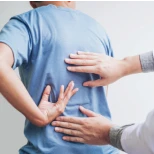
Back Pain
1 in 6 people in England have back pain. Often it isn’t a ‘serious’ problem but if the pain stops you being active and exercising an injection could help.

Neck Pain
Modern lifestyle has increased incidents of neck pain. When pain radiates into the arm or hand you should be assessed properly by a spine doctor, the neck should not be manipulated.

Sciatica
Pain in the lower back, buttocks and down the legs could be sciatic. Once the underlying cause is identified a targeted injection can help ease the symptoms if they are not settling.
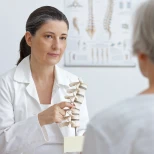
Arm Pain
A ‘pinched nerve’ in the neck can cause arm pain. Your hand or fingers may tingle or go numb and muscle weakness can occur. A targeted injection can aide recovery.
